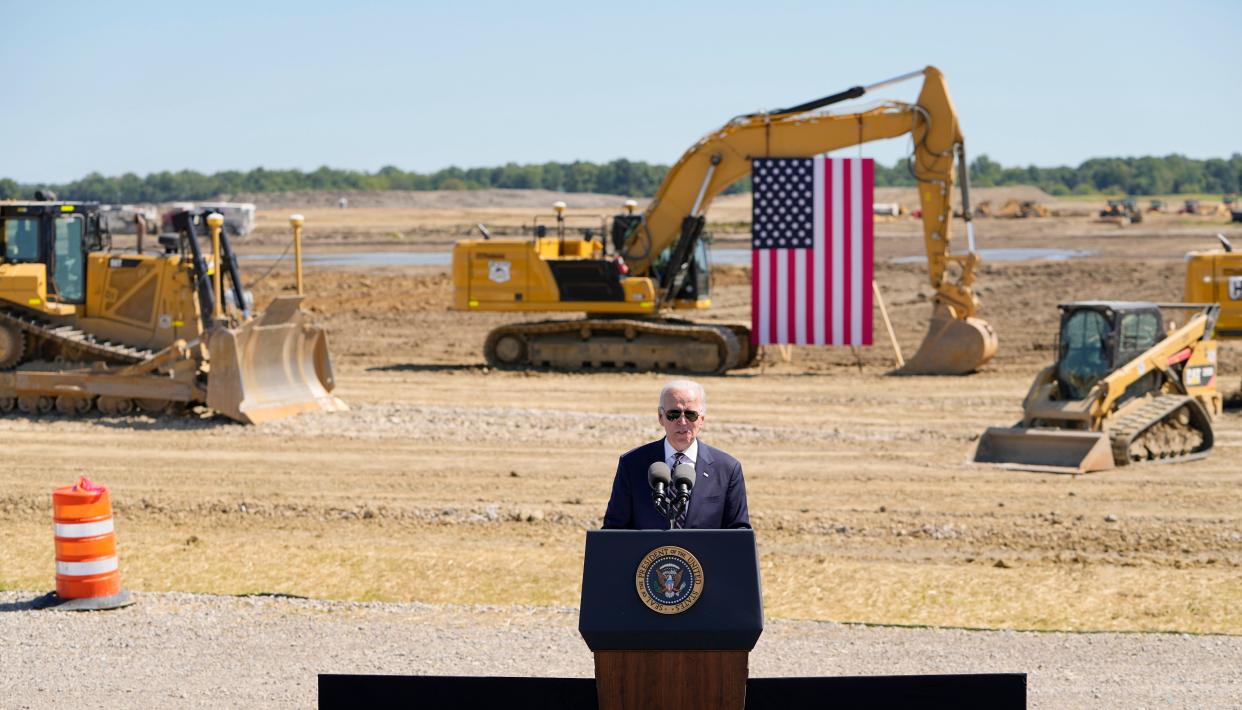Ohio welcomes Biden, Intel for $20 billion groundbreaking

West Coast technology officially came together Friday with Midwest manufacturing prowess to create the Silicon Heartland.
Under a sun-splashed late summer day, President Joe Biden joined Ohio political, educational, union and business leaders to break ground on Intel's $20 billion project in Licking County to create the world's most advanced semiconductor factories. It is the state's largest economic development prize.
Friday's groundbreaking also served as a celebration of the recently enacted CHIPS and Science Act that is meant to restore U.S. production of the tiny devices that power everything from cellphones to computers to cars to military equipment that has been largely shipped overseas. Biden signed the legislation into law last month, and Intel has said the legislation will play a meaningful role in how it develops the site in Ohio.
Shortages of the chips have plagued the economy since the pandemic and have contributed to the rising cost of cars and other products.
President Biden gives speech on site of Intel microchip factory project groundbreaking
"Folks, we need to make these chips right here in America to bring down everyday costs and create good jobs,’’ Biden told about 700 people who gathered at the site.
Intel has been working for about two months at the site, and not even Friday's ceremony stopped the earth moving work taking place behind the temporary stage where Biden, political leaders, educational leaders, Intel executives and others spoke.
"The Rust Belt is dead and the Silicon Heartland begins," Intel CEO Pat Gelsinger said.
"This idea of Silicon Heartland (is) an epicenter of leading-edge technology, and Intel's factories right here will produce the most advanced process technologies in the world," he said. "Our customers .... need the best stuff for their products, everything from high-performance mobile, artificial intelligence, advance computing, cloud, all of that will be a result of these factories behind us."

Gelsinger called the CHIPS Act the most significant piece of industrial legislation since World War II. Intel has said it is too soon to determine how much benefit it will get from the legislation.
The CHIPS Act provides $52.7 billion in incentives, plus tax incentives, for companies to research, design and manufacture semiconductors and to help with workforce development.
As he did in his State of the Union speech in March, Biden said the 1,000-acre New Albany site is a "field of dreams where America's future will be built."
American production of semiconductors has stumbled from 37% in 1990 to about 12% today, and that has put the country at risk as other countries offer billions of dollars to lure semiconductors, Biden said.
The legislation has triggered a series of announcements by companies across the country to build semiconductor operations, Biden said.
"The future of the chip industry is going to be made in America," he said
The groundbreaking caps a frenzied eight months since Intel picked Licking County from a nationwide search as its spot for what could become the world's largest semiconductor operation with as many as eight plants - called "fabs" in the industry - and a total investment of $100 billion.
The plants will employ 3,000 workers, earning an average of $135,000. There will be 7,000 construction workers at the site as well. The plants also are expected to be a draw for Intel suppliers who will create thousands more jobs.
The Licking County plants are expected to start producing semiconductors in 2025.
"We can, we must and we will make them here," Gov. Mike DeWine said.
DeWine called the groundbreaking an historic moment for the state.
"We celebrate a great victory for Ohio, but an even greater victory for our country," he said.
What will Intel's plants in New Albany make?
Intel has said the campus in New Albany will be among its most advanced, turning out semiconductors with a variety of applications for cars, cellphones, computers, and other devices critical to a modern economy.
"It is a very important site. ... This will be a top-notch fab, the most advanced fab in the country and the planet," Intel Senior Vice President Randhir Thakur said in an interview with The Dispatch.
Beyond that, the plants are expected to play a key role in Intel's new foundry business that was launched last year and is being led by Thakur.
Foundry work comes from companies that design their own semiconductors, but use other companies to make them. Until now, it's been a tiny part of Intel's business, but Gelsinger has pledged to make it a much bigger part of Intel's business, and that includes the new plants in Ohio.
As part of this foundry work, Thakur said the New Albany plants will manufacture chips for the military and military contractors. Intel has said it expects the market for foundry work to grow from $90 billion a year to $200 billion a year by 2030.
Exactly how much of that business will be done in Ohio will be determined over time, Thakur said.
Groundbreaking receives bipartisan support
Politicians from both sides of the aisles have rallied around the Intel project. A host of state legislative leaders praised the project as did Sens. Rob Portman, a Republican, and Sherrod Brown, a Democrat, during Friday's ceremonies that ran for more than two hours.
"Today as we acknowledge all the hard work that went into bringing Intel to Ohio, we also acknowledge the hard work before us that now begins as we begin to close America's competitiveness gap that has grown dangerously wide in regard to semiconductor manufacturing," Portman said. "I'm really proud Ohioans will play an important role in closing this gap."
Brown said in January when he flew to Ohio for the Intel announcement that the news marked a major change for the Ohio economy.
"I remember looking out the window of the plane at all the places that have been long been ignored by Wall Street and passed over by corporate America and forgotten by our government, and I thought about how from that day forward we're going to change that," Brown recalled telling Portman and others on the flight, "Today we're burying the term Rust Belt."
Industry leaders welcome Intel project
"It's hard to state how important this is," said Jay Timmons, president and CEO of the National Association of Manufacturers and a native of Circleville, who attended Friday's groundbreaking.
"We see what happens when we depend on critical products coming from overseas, especially during the pandemic," Timmons said, noting how hard the shortage of semiconductors has made it to buy cars, for example.
The CHIPS Act demonstrates how indispensable technology is in today's economy, and the law is critical to help ensure that shortages don't happen again, said Jason Oxman, CEO of the Information Technology Industry Council, a global advocate for technology.
"For both economic reasons and national security reasons, growing semiconductor manufacturing in the U.S. is vitally important," Oxman said. "We don't have to speculate on what a shortage of semiconductors means to the U.S. economy."
mawilliams@dispatch.com
@BizMarkWillliams
This article originally appeared on The Columbus Dispatch: Biden visits Ohio to break ground on $20 billion Intel project

